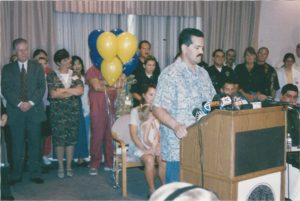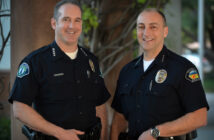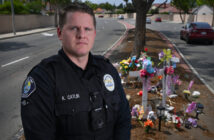His wife and kids never really brought it up. Until this year.
“Dad,”his 18-year-old daughter, Alexis, turned to him and said, “You have an anniversary coming up.”
Thomas “Kasey”Geary was taken aback.
His wife and four children had avoided the subject over the last 14 years —even when, every summer, the anniversary approached.
Geary, 53, a Motor Sergeant in the Traffic Bureau of the Anaheim Police Department, where he is coming up on 32 years of service, recalled the recent exchange with his daughter.
“Yeah,” he told her. “It’s the anniversary of you not getting on my hospital bed.”
That anniversary is today.
Fourteen years ago, Alexis was 4 when her father was shot in the face while making a traffic stop on a dark freeway onramp in the dead of night. At the time, Geary was 39 and a 17-year Anaheim PD veteran.
During his recovery, Alexis was too scared to hop onto her father’s hospital bed.
Sipping on a soft drink Tuesday at police headquarters, Geary recounted the horror of taking a bullet to the face, his lengthy and often difficult recovery, his feelings about the locked-up shooter who nearly killed him, and how the incident changed his perspective on police work.
“I remember seeing the gun,” recalled Geary, who still has the intact slug from the .45-caliber handgun lodged between his C5 and C6 vertebrae.
“I don’t really remember being shot.
“I remember my ears ringing, and when I came to, I remember being on my back.
“I remember looking up at the stars and thinking, ‘Is this where it’s going to end? At Ball (Road) and the 57 (Freeway)?’”
***

A scar on Geary’s left jawbone is noticeable.
So is his slow, slightly-off gait.
Geary is partially paralyzed on his left side, with 41 percent normal functionality.
He can’t grasp firmly with his left hand. He only has feeling in his left pinkie.
Some invisible scars are permanent: Geary struggles with patience and high-blood pressure. Chronic pain keeps him from sleeping soundly for more than 45 minutes.
Paranoia and anger are quick to resurface, said Geary, who underwent two years of intensive therapy to cope with post-traumatic stress disorder.
He has some problems with memory —as he put it, “a little bit of erased tape.”
He feels nothing but disdain for the shooter, who at the time of the cold-blooded crime was a 25-year-old gang member from Santa Ana suspected of dealing drugs out of a seedy Anaheim nightclub.
“I thought about the whole forgiveness thing,” Geary said of Juan Carlos Alcaraz, who is serving multiple life terms at California State Prison in Corcoran —home of such notorious bad guys as Charles Manson and Juan Corona, who slaughtered 25 itinerant laborers with a machete.
“I thought about reaching out to him,” Geary said, “but he altered my life so dramatically.
“I just can’t do it.”
***
Geary, who grew up on a small street in downtown Anaheim where two motorcycle patrol officers had homes, always wanted to be a cop.
He kept that dream alive when, at age 15, his mother kicked him out of the house to live with his father, an alcoholic.
That didn’t last long.
Despite living out of a van for a couple of years, Geary stayed out of trouble and kept his dream of becoming a police officer alive while earning decent money in the floor-covering business. He was a reserve officer with the Anaheim PD for about four years before becoming a full-time cop in 1986.
Before he was shot, the worst thing to happen to Geary while on duty was being stabbed in the forearm while responding to a bar fight.
Then came July 10, 2000.
After working in the gang and vice units, Geary was back on patrol and was halfway through his shift when, at about 1:50 a.m., he pulled Alcaraz over on the onramp of the southbound 57 at Ball.
Geary, his service weapon drawn, saw the flash of the handgun as he approached the stolen Ford Explorer.
Bam!
Alcaraz had fired through the open, right-rear passenger window, holding the gun behind the seat occupied by his 15-year-old female companion.
A passing motorist helped a still-conscious Geary call for aid as the stunned cop instinctively sought to stem the bleeding.
“I felt the blood pouring out under my vest,” Geary said.
Two female police officers arrived and applied pressure to the wound before paramedics arrived and whisked Geary to UCI Medical Center in Orange.
Geary’s wife, Catherine, an Orange County Sheriff’s deputy who was working the jail shift when her husband was shot, almost beat him to the hospital.
Geary recuperated for eight months before returning to work.
“I thought, ‘I’m not done,’” Geary recalled. “I didn’t want this (shooter) to take my career from me.
***
Before he was shot, Geary described himself as “a hard-nosed, very active, no-nonsense street cop”—not the most sympathetic officer when it came to nabbing suspects.
Being shot in the face, Geary said, changed him.
Surviving the bullet, and witnessing the huge outpouring of support from fellow officers and the community, softened him some, Geary said.
“I’m still old school,” Geary said, “but this is a people business. There’s no room to be (unpleasant) to people.”
Following the shooting, Geary helped raise $40,000 to spruce up the home of an elderly female hoarder and see to it that she received proper mental health care.
Geary’s children now are 31, 30, 18 and 13. He plans to retire from the APD when he turns 55 in 2016.
For now, though, there’s no doubt where he belongs.
“This is my world,”he said.
Geary said he doesn’t think much about what happened July 10, 2000, or about the bullet permanently lodged in his body.
But, he said, he made a pact with his wife if he dies before she does.
“I told her to make sure (doctors) take it out,” Geary said.
“I don’t want to be buried with that bullet in my spine.”
 Behind the Badge
Behind the Badge




